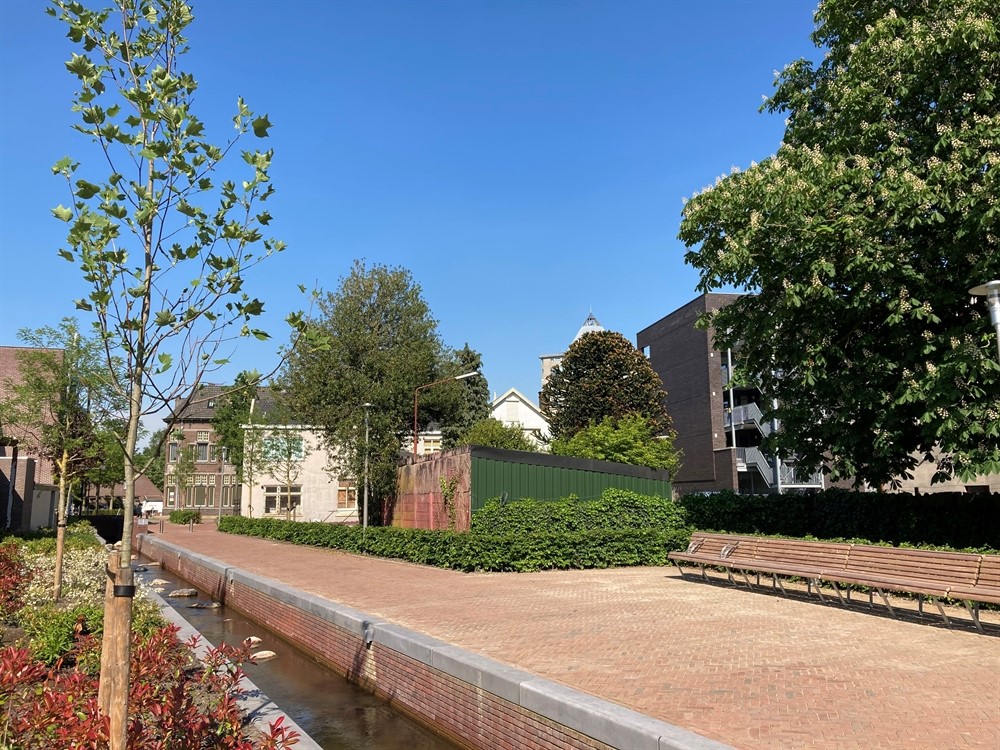Water flows through Apeldoorn Climate Street
Since 23 April 2021, water has been flowing through Apeldoorn city centre. The construction of this Marktstroom stream forms part of the “Climate Street”, comprising Marktstraat and Beekstraat streets, which connects to Grifthof plaza. These streets have been adapted to the changing climate.
What has prompted the project?
Over recent years, Marktstraat and Beekstraat in Apeldoorn city centre had been presenting a gloomy sight. Many buildings were vacant; several shops, cafés, and restaurants had disappeared from these streets. In collaboration with entrepreneurs, the municipality has devised a plan to revive the streets and enhance their spatial quality. Climate adaptation has become a key element in this plan.
What measures have been taken to combat waterlogging and drought?
In the streets, the following adaptation measures have been taken to combat waterlogging and drought:
- In Markstraat street, a small water stream featuring sprinklers has been created: the Markstroom. The Marktstroom collects rainwater and accommodates excess groundwater. For many years, groundwater was discharged underground in order to keep the parking garage underneath Markt square dry;
- The Marktstroom water is collected in an underground receptacle, whereupon it flows back to the beginning of the Marktstroom several times a day. The water is also purified;
- The municipality has constructed a cistern: a large underground water storage facility. During severe downpours, this cistern collects rainwater via a narrow metal gutter created along the Marktstroom. The cistern can hold 200,000 litres of rainwater. During periods of drought, the municipality can use this rainwater to water the greenery in the city centre. At the surface, the cistern has been made visible in the form of a glass-covered well. Thus, every passer-by can witness that Apeldoorn is using rainwater in a sustainable manner;
- The Marktstroom water flows out into the Grift brook zone. Step by step, the Grift underground brook has been returned to the surface. In the city centre, the municipality and the district water board have also restored a section of the Grift. This brook zone opens up opportunities for nature development; for example, fish passages and fish breeding grounds have been provided. Along the brook, a footpath has been created.

What greening measures have been taken?
The new Climate Street has also made Apeldoorn city centre considerably greener:
- A new feature is, e.g., Grifthof plaza, comprising a great deal of greenery, water, and a wadi. This peaceful plaza is perfect for residents to take a break. Before the construction of Grifthof plaza, the area was quite cluttered, covered in pavement and bordered by rear aspects of private properties. Now it is a new, green plaza in the city centre, accessible to everyone;
- At the end of 2018, the municipality created a small, green park right in the middle of Marktstraat street, called the Markthof. Existing trees were given more room. A border was created with a wide variety of colourful plants, attracting bees, butterflies, and people. The park features a drinking water tap and a spacious bench;
- The municipality has also planted trees, shrubs, and perennials in the city centre streets;
- In collaboration with homeowners, the municipality has greened façades and placed planters. At several locations, green garlands have been hung across a street.

How is this street adding to the city’s climate resilience?
Rainwater is collected in the Marktstroom, the wadi, the receptacle, the cistern, and the Grift. Part of the Grift water will infiltrate downstream into the soil. This range of water collection provisions greatly reduces the city’s vulnerability to waterlogging and drought. Severe downpours will not result in water on the streets, whilst in periods of drought, the water collected can be used for urban greenery. The green parks – Markthof and Grifthof – and the trees and plants in the streets and at the façades provide cooling during warm days. Furthermore, they foster air quality and biodiversity.
What else does the Climate Street feature?
The Climate Street has also become a place for children to play. They can splash about in the purified water from the sprinklers along the Marktstroom. Other noteworthy features in the Climate Street:
- Engravings in the Marktstroom represent the various fish species swimming in the Grift and in other Apeldoorn brooks;
- Building owners are investing in properties in the two streets and around Grifthof plaza. Many properties have meanwhile been renovated. The owners have restored historic façades with support from the Apeldoorn municipal façade fund;
- Local entrepreneurs are working here with a great deal of enthusiasm, radiating positive energy. Their guts, time investments, monetary investments, and many entrepreneurs’ eye for quality have played a large part in the beautiful result.
Residents of new apartments in the vicinity of the Climate Street appreciate the mixture of water, greenery, history and new, living, shopping, and small-scale restaurants. The street is attracting more visitors who spend more time there. The Climate Street is alive!
Collectively devising, testing, and measuring
The Climate Street is the result of concerted efforts and collectively trying out things. Residents, entrepreneurs, the district water board, the province, the central government, and the municipality have collectively realised the Climate Street. For example, streets have been greened together with residents and entrepreneurs, whilst the Apeldoorn in Data private initiative is measuring the temperature with sensors, in order to verify whether the streets are actually cooler.
Lessons to be learned
Good communication is invaluable. The municipality has set up group meetings and conducted one-to-one talks with owners and occupiers of the buildings. Drawings of the façades of all the buildings, with proposals for greenery on or at the façades, have enthused the owners and occupiers to participate in greening their street.
Contact person
Hendrieke Rossingh
Gemeente Apeldoorn
H.Rossingh@apeldoorn.nl
